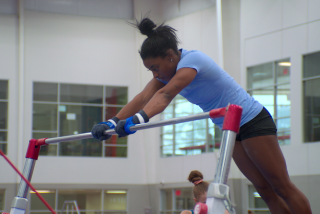COMMENTARY : Seles’ Return Orchestrated to Enhance Graf Rivalry
- Share via
Monica Seles has thrown down the gauntlet directly at Steffi Graf’s feet. Not two hours after Graf had claimed her sixth Wimbledon singles title, by beating Arantxa Sanchez Vicario in one of the most stirring finals in Wimbledon history, Seles held a news conference on this side of the pond to announce her intention to play in the U.S. Open--the next “major.” To accentuate the moment Seles allowed herself to be photographed hitting groundstrokes.
Coincidence? I don’t think so. Nor do I think it was coincidence when Seles announced her upcoming exhibition match with Martina Navratilova during the second week of the French Open, stealing a headline from that event. Seles has always had a knack for selling Seles.
Perhaps Seles felt she had cover because the announcement was made in conjunction with her appearance at the Special Olympics in Connecticut. But Seles could have easily refrained from talking about her own tennis plans--which she knew would make news--for a few days and let Graf glow in a solitary spotlight. Instead, Seles big-footed Graf’s moment. This is how you stoke a rivalry.
No one who follows tennis can be unaware that Seles was the No. 1 player on the women’s tour before she was stabbed. Seles reached the finals in the last eight majors she’d played, and she’d won seven! Three Australians, two French and two U.S. championships. At just 19 years old, Seles had already left Graf in her rear view mirror. So Graf’s dominance in the past 27 months (six major titles, including four in a row after Seles was stabbed) is unmistakably attributable to Seles’ absence. Compounding the situation is the fact that Gunther Parche, the lunatic who stabbed Seles, misbegottenly did it to help Graf. Clearly, such a mad swirl could create a dicey relationship between Seles and Graf.
All this heightens the anticipation for Seles’ return. Every fan of women’s tennis wants to see Graf square off with Seles--so Seles has a chance to recapture her crown, and Graf has a chance to erase the asterisk that accompanies her accomplishments of the past 27 months. Hasn’t it been made abundantly clear that no woman other than Seles is a significant threat to Graf? Graf’s own bad back threatens her more than any player.
Graf-Seles stacks up as the one compelling rivalry in women’s tennis, the latest in the line of King-Court, King-Evert, Evert-Navratilova, Navratilova-Graf. (Though Seles would be well served to show some sympathy for Graf. True, Seles was stabbed, and Graf wasn’t. But while Graf suffered no physical harm, she could certainly have suffered emotional harm from the incident. How could it not be traumatic knowing that one of Graf’s “fans” stabbed Seles because of her? Jodie Foster underwent a similar circumstance when one of her “fans,” the deranged John Hinckley, attempted to assassinate Ronald Reagan to gain Foster’s attention. Unlike Foster, who was able to retreat out of the public eye for a while, Graf has remained front and center on the tour.)
In recent weeks, as it has become clearer that Seles was inching her way back to the tour, a hubbub has sprung up about where she should be ranked; she was, after all, No. 1 when she was forced to the sidelines through no fault of her own. To smooth over her return there was talk about giving Seles a co-No. 1 ranking, and granting her special exemption from the rules of how rankings are determined. But some highly ranked women on the tour, including Sanchez Vicario, balked at this. I think the ranking issue is a tempest in a teapot. Seles has been gone 27 months; any number they give her is going to be artificial. If she’s worried about seedings, the only tournament where that would matter is the U.S. Open, and like all “majors” the Open reserves the right to make its own seedings and ignore the computer rankings. If Seles is anywhere near as good as she was when she left tennis, she’ll be in the top five in no time.
More to Read
Go beyond the scoreboard
Get the latest on L.A.'s teams in the daily Sports Report newsletter.
You may occasionally receive promotional content from the Los Angeles Times.










